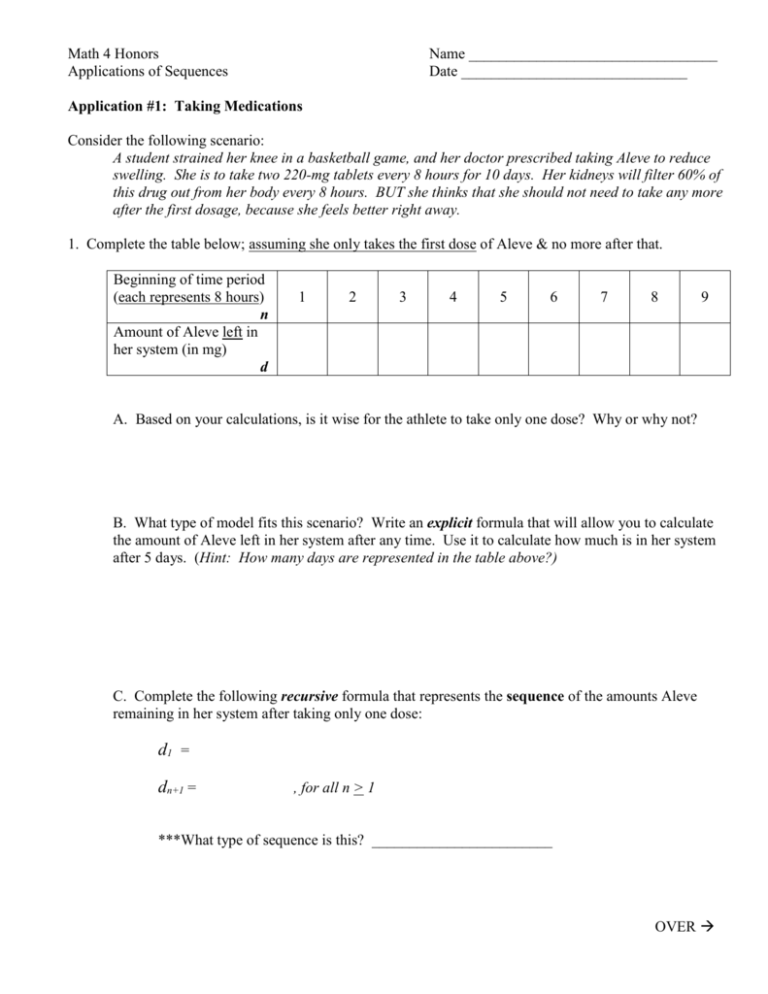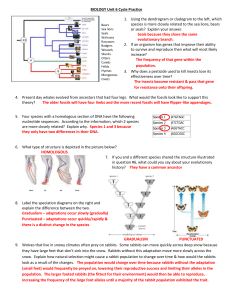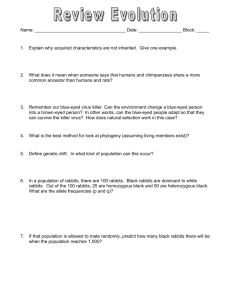Applications of Sequences
advertisement

Math 4 Honors Applications of Sequences Name _________________________________ Date ______________________________ Application #1: Taking Medications Consider the following scenario: A student strained her knee in a basketball game, and her doctor prescribed taking Aleve to reduce swelling. She is to take two 220-mg tablets every 8 hours for 10 days. Her kidneys will filter 60% of this drug out from her body every 8 hours. BUT she thinks that she should not need to take any more after the first dosage, because she feels better right away. 1. Complete the table below; assuming she only takes the first dose of Aleve & no more after that. Beginning of time period (each represents 8 hours) n Amount of Aleve left in her system (in mg) d 1 2 3 4 5 6 7 8 9 A. Based on your calculations, is it wise for the athlete to take only one dose? Why or why not? B. What type of model fits this scenario? Write an explicit formula that will allow you to calculate the amount of Aleve left in her system after any time. Use it to calculate how much is in her system after 5 days. (Hint: How many days are represented in the table above?) C. Complete the following recursive formula that represents the sequence of the amounts Aleve remaining in her system after taking only one dose: d1 = dn+1 = , for all n > 1 ***What type of sequence is this? ________________________ OVER 2. You have convinced the student to follow her doctor’s recommendation. She will take two 220-mg tablets of Aleve every 8 hours for ten days. Remember that her kidneys will filter out 60% of the Aleve from her body every 8 hours. She would like to know how much of the drug will be in her system each of the 10 days. A. Make a table similar to the one from question 1 to illustrate this scenario. (Hint: How many dosages will she take over 10 days?) B. Enter your data into your calculator & create a scatterplot. Sketch your graph below. C. Write a recursive formula to represent this scenario. D. Based on your graph, about how much Aleve would remain in her system if she continued to take it for a year? d (n) _________ Complete the following: nlim FYI: The 2nd scenario is an example of a logistic model, AKA, a limited growth model. Application #2: The Fibonacci Sequence and Nature The purpose of this scenario is to investigate what mathematics has got to do with the birth rates of rabbits and the petals of flowers. Section A: Rabbits 1. Ralph bought a pair of rabbits (one male and one female) in Jan 2004. The rabbits did not produce any rabbits in Feb 2004 but they produced a new pair of rabbits (one male and one female) every month from Mar 2004 onwards. Each new pair of rabbits followed the same behavior. For example, the pair of rabbits born in Mar 2004 did not produce any rabbits in Apr 2004 but they produced a new pair of rabbits every month from May 2004 onwards. (a) How many new pairs of rabbits are produced at the end of Mar 2004? ________ (b) How many new pairs of rabbits are produced at the end of Apr 2004? ________ (c) Draw a model or a diagram in the table below to show the number of new pairs of rabbits produced at the end of each month from Jan to Sep 2004. Some parts have been done for you. Complete the table also. 1st pair of rabbits Pairs produced by 2nd pair Pairs produced by 1st pair Pairs produced by 3rd pair For other pairs produced, you can use the same symbol Total New Pairs at End of Month Total Pairs at End of Month Jan 0 1 Feb 0 1 Mar 1 2 Apr 1 May 2 Month Model Jun Jul Aug Sep 2. 3. 4. The last column in the table above shows the total pairs of rabbits at the end of each month. This number pattern is called the Fibonacci sequence. Explain how you get the next term. Write a recursive rule for the sequence. How many pairs of rabbits were there at the end of Jan 2005? ______________________ OVER Section B: Flowers 5. Write down the number of petals for each flower below. Picture A: White Calla Lily Picture B: Euphorbia ______ Picture C: Waterplantain ______ Picture D: White Vinca ______ ______ Picture E: Moonbeam Coreopsis Picture F: Orange Zinnia 6. ______ What do you notice about these numbers? ______ 7. Is the Fibonacci sequence arithmetic, geometric or neither? Explain. Application #3: The Tower of Hanoi and the End of the World “The Tower of Hanoi (sometimes referred to as the Tower of Brahma or the End of the World Puzzle) was invented by the French mathematician, Edouard Lucas, in 1883. He was inspired by a legend that tells of a Hindu temple where the pyramid puzzle might have been used for the mental discipline of young priests. Legend says that at the beginning of time the priests in the temple were given a stack of 64 gold discs, each one a little smaller than the one beneath it. Their assignment was to transfer the 64 discs from one of the three poles to another, with two important conditions: only one disc can be moved at a time and a large disc could never be placed on top of a smaller one. The priests worked very efficiently, day and night. When they finished their work, the myth said, the temple would crumble into dust and the world would vanish.” (www.lhs.berkeley.edu/Java/Tower/towerhistory.html) Section A: How does it work? 1. Start with 3 discs on the leftmost pole. Explain, with the help of diagrams, how you move all the 3 discs from the leftmost pole to the rightmost pole. Record the minimum number of moves in the table in question 5. 2. Start with 4 discs on the leftmost pole. Which pole should you move the first disc to? _____ Record the minimum number of moves in the table in question 5. 3. Start with 5 discs on the leftmost pole. Which pole should you move the first disc to? ______ Record the minimum number of moves in the table in question 5. 4. Start with 6 discs on the leftmost pole. Which pole should you move the first disc to? ______ Record the minimum number of moves in the table in question 5. Section B: What is the minimum number of moves? 5. Complete the table below. No. of Discs, n Minimum No. of Moves 1 2 3 4 5 6 7 OVER 6. Is there any pattern in the minimum number of moves required? State the general formula for the minimum number of moves in terms of the number of discs n. Recursive Rule: Explicit Rule: 7. Is this sequence arithmetic, geometric or neither? Explain. 8. In the Legend told in page 1, the end of the world will arrive after the priests have moved all the 64 gold discs. Assuming that each gold disc is small enough for a priest to move from one pole to another pole in 1 second, when will the end of the world arrive? Give your answer in terms of years.




